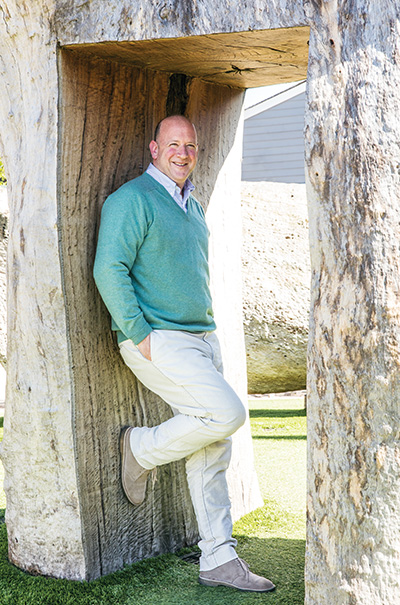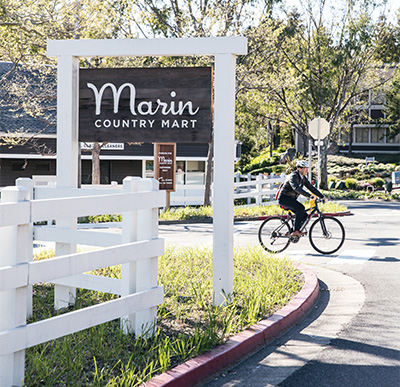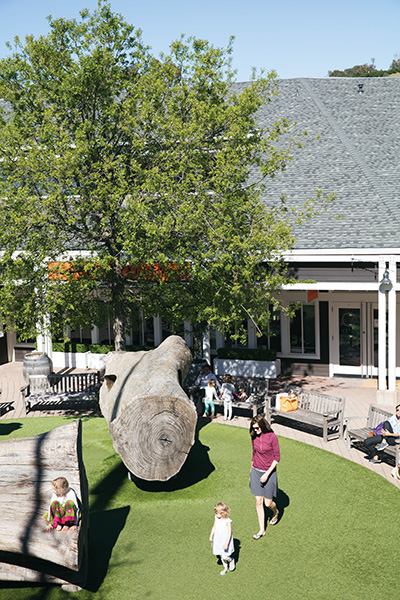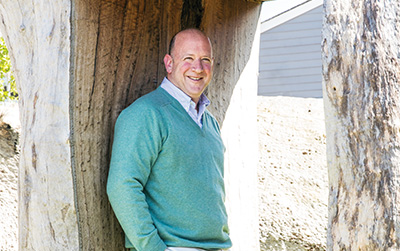
FORGET FOCUS GROUPS. Forget market research. When Jim Rosenfield, head of the group that owns Marin Country Mart, designs a shopping mall, he relies on instinct, his training as an artist and flat-out good taste. Oh, and a dash of nostalgia too. “When I talk about having a vision for retail property, I’m not talking about stable rents or credit-worthy tenants,” he says. “That’s not a vision. I’m talking about, what type of retail environment do you want to create? For me, personally, I like old-fashioned villages.”
Walk through any of Rosenfield’s three Country Marts (the other two are in Southern California’s Brentwood and Montecito) and you see this affection for the past, for places where people can gather and create community. Each contains a post office, barbershop, bookstore, shoe repair shop and toy store. It was Rosenfield’s desire to reconnect with his own past, however, that brought him to Marin.
A Los Angeles native, he fell in love with the Bay Area when he attended UC Berkeley in the ’80s. He later married his wife, Heather Whitney Rosenfield, in Bolinas, and lived all around the country and world while trying to figure out a way to get back to the Bay Area for good. He wanted to get back so much that one day in 2009, he spent the entire day driving up and down Highway 101 with several employees, getting off at every exit, looking for the project that would allow him to make Marin his home.
He found it at the Larkspur Landing shopping center. The roughly 18-acre site had 12 buildings around a courtyard, with parking around the periphery and easy access from Sir Francis Drake and 101. It didn’t matter that it wasn’t for sale. Rosenfield called his architect to take a look. “He said, ‘This is a great idea,’ ” Rosenfield says. “But of course it was 2009 and the economy was bad, and architects really just wanted the work.”
On the face of it, the Larkspur Landing shopping center was not necessarily a sure hit. Built in the ’70s, it had struggled for years, says Neal Toft, the city of Larkspur’s planning and building director. “When I came here in the early 2000s,” Toft recalls, “the center was challenged even to bring in Bed, Bath and Beyond.” A large portion of one building was taken over by an AAA office.
Deciding he needed to create something Marin-centric, he sought out local retailers like Hudson Grace and Erica Tanov, as well as the meat vendor Belcampo, which eventually opened its first retail location in the mall. He knew he wanted the center to feel like a village. But “the more time I spent with friends and neighbors in Marin,” he says, “I realized that people had maybe had enough of live-edge wooden tables and such. What they kept asking for were things we had at the Brentwood Country Mart in Los Angeles.”
With that info in mind, he lured a number of SoCal restaurants (Farmshop, for example) and stores north and undertook a roughly $10 million renovation, drawing on his varied experience — which included not only commercial real estate successes but also a midcareer sabbatical at the Slade School of Art in London, where he studied painting and drawing — to create the new Country Mart.
All along, he wanted the place to still feel like Marin. “The original developer imagined this as a New England maritime village, and the second owner renovated the place to be like the piazzas of Italy,” Rosenfield says. “I looked at this and thought it should get its inspiration from California, and particularly form West Marin, which I love. I wondered: if we got our inspiration from Point Reyes, Inverness, Bolinas and Marshall, what would the landscaping look like? What would our buildings look like?”

One of his initial calls was to Lawrence Halprin, the famed Bay Area landscape architect who designed San Francisco’s Ghirardelli Square and the Franklin Delano Roosevelt Memorial in Washington, D.C., and whose office was just across Sir Francis Drake. Though Halprin was mostly a consultant on the project and died before it was completed, he helped create a plan to make Country Mart more evocative of Marin.
First up: removing a stand of black acacia trees along Sir Francis Drake to open up the views of both Mount Tamalpais and the bay. Rosenfield replaced the trees with roughly 6,000 lavender plants (along Sir Francis Drake and the perimeter of the parking lot) and simultaneously began renovating the courtyard, pulling out the paver-tiled hardscaping and replacing it with landscaping, planting more trees and trying to save the ones that were there, many of them planted in holes too small. “It felt like a sad corporate park to me,” says Rosenfield, “so we bought 50- to 100-year-old olive trees with big 10-foot root bulbs and dug holes so they would be happy here and grow even bigger.”
Rosenfield also hired West Marin wood artisan Evan Shively to create what the landscaping- ideas website Gardenista has called “the best play structure ever” in the center of the courtyard: three sculptures made from eucalyptus trees that had fallen on Highway 101, each with cutouts where kids could play. The enormous logs are dramatic and breathtaking, as much art as they are playground.
Which is no surprise, considering Rosenfield’s background as a painter. “He looks at everything from an artist’s perspective,” says his wife, Heather, who founded Poppy Store and is partners with Reese Witherspoon on the Draper James women’s clothing line. “Every single detail at Country Mart, even the things most people don’t notice, is the result of his artistic viewpoint. He’s more interested in the scale and very subtle color changes and the width of wood and type of wood than anyone I know.”
That penchant is apparent in the carefully selected paint colors of the buildings — ranging from barn-like red, gray, brown and black to dark green and white — and even in the bathroom colors, which draw their inspiration from one of Rosenfield’s favorite places, Sea Ranch. Rosenfield liked the bathrooms there so much he hunted down Barbara Stauffacher Solomon, the supergraphics artist who painted them in the ’60s, and asked her to paint her bold stripes in the Country Mart restrooms.

His design touch is apparent in the shops as well. Inspiration for the bookstore Diesel’s cork floors, wood-paneled walls and fireplace came from UC Berkeley’s Morrison Reading Room. And Rustic Bakery’s design reflects Rosenfield’s fondness for old-fashioned bakeries and the sense of community they can promote. On his insistence, everything there is baked on site and the kitchen is visible from the seating area; he even had a say in the tables. “The communal tables are counter height, which brings people together, and the tables are narrow enough and short enough that you share [space],” says Rosenfield. “A lot of social things happen in these places because of our design.” It’s not uncommon at Rustic to see strangers sitting together at tables and talking, something they may not have done if the restaurant only had small individual tables.
Rosenfield also sought uniquely Marin-style tenants, combining laid-back health-minded outlets like Yogaworks, SoulCycle and grass-fed meat vendor Belcampo with high-end retailers like Erica Tanov, James Perse and Intermix, where a T-shirt can retail for $500. Social energy is further enhanced by events like a farmers’ market on Saturday and Off the Grid food truck confabs on Sunday. “Jim nailed it, in terms of creating an environment appropriate to Marin,” says Chris Meany, whose firm Wilson Meany renovated the San Francisco Ferry Building. “Everyone feels like, ‘Oh, we’re going to the little low-key place down the road,’ but of course, this is a very sophisticated, affluent market.”
Marinites have responded enthusiastically. In the last seven years, visits to the mall have more than doubled (hence the always-packed parking lot) and sales there have more than tripled.
Rosenfield, a perfectionist, has created this winning formula in part by finessing the most minute elements, bottom line occasionally be damned. Take, for example, the three-rung equestrian fence that borders the shopping center. For its construction, he purchased oldgrowth reclaimed redwood, one of the most costly woods available. But after the 5-by-5-inch posts were painted and installed, he thought they looked too small.
“I was tortured by it,” Rosenfield says. So he had his laborers pull up all the posts — reusing them elsewhere on the property — and replace them with 6-by-6-inch posts, which felt more substantial. The new fence had the agricultural look he was after, akin to what might be seen in the rolling hills of Marshall. “Everyone around me said, ‘It doesn’t matter, no one is going to know except you.’ But I had to do it,” Rosenfield says. “It’s not about knowing. It’s about feeling.”


